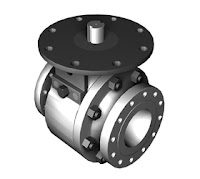 |
| Intelligent Control Valve and Loop System |
Advantages for using this type of device are the following:
Process Diagnostics – Evaluation of process equipment is possible with the StarPac intelligent control system. By generating an initial signature of the process and then identifying a standard process signature, a pump, compressor, heat exchanger, reactor, etc., can be discovered to be defective and in need of servicing. Process diagnostics can be per- formed with a personal computer or DCS connected to the unit via its serial data port.
Logging / Tuner Operation – The StarPac will take a 'snapshot' of process conditions at user-specified intervals (1 to 9999 seconds) and store them in its memory for later retrieval to aid in diagnosing process upsets. The personal computer operator interface will trend process variable, set point, and stem position to aid in tuning the control loop. This data is in a form that can be read by loop auto-tuning software to calculate the optimum PID constants.
Process Transmitters – The StarPac has sensors in the valve body to measure process conditions including upstream and downstream pressure, temperature, and flow. Flow is indicated both as the current value and a totalized amount. For gases, flow is reported in mass units, such as pounds per hour (since gas flow is always compensated for changes in pressure and temperature). Other sensors measure stem position and pressures in the top and bottom chambers of the cylinder actuator. All of these values are available over the serial link to a computer or DCS.
Connections to Operator Interface – The StarPac can be connected to an operator interface (personal computer, DCS console or hand station and recorder) through its analog, discrete and digital channels. The StarPac houses two analog inputs and one analog output. Up to six analog outputs are available using an external converter module. Two discrete inputs and two discrete outputs are also available at the StarPac. The user can define how these channels will be defined. Normally one analog input is a command signal, one discrete input sets the control mode, and the discrete outputs signal alarm conditions. The digital channel can be connected to computers and most DCSs through gateways or Modbus ports. All of the process and configuration information is available through the digital channels.
High Interchangeability – Since the Valtek Mark OneTM, MaxFloTM and ShearStreamTM control valves are the basis of the StarPac system, most valve parts are interchangeable with other Valtek valves, reducing parts inventory.
Local Display – Eight variables (P1, P2, temperature, gas flow, liquid flow, total flow, setpoint, stem position) can be displayed on a liquid crystal display in the electronics module. Each variable can be set to display continuously, or the StarPac can be set to scroll through the chosen variables at ten-second intervals. An error indicator will show if the StarPac system should fail any internal diagnostic or if the process is out of range.
Multiple Failure Modes – StarPac technology allows multiple failure modes to be set, including: power, air supply, command signal, or process failure. This results in greater reliability and consistency of the process during emergency shutdowns, protecting the process and people.
Valve Diagnostics – A maintenance feedback package allows StarPac intelligent systems to display the condition of the valve packing, seat, actuator, and O-rings with only a brief process interruption without removing the valve from the line. PC software displays the actuator or process signature for analysis. Optional valve diagnostic software can determine specific valve failures.
User Friendly Software – When the user is not connecting the StarPac unit to a DCS, StarTalk software can configure, operate, and diagnose the StarPac unit through a personal computer. The software has a graphical user interface, allowing most users to operate their StarPac systems with minimal training.
Environmental Considerations – Locating pressure and temperature sensors in the valve body eliminates several process connections. All pressure sensors have at least two seals to reduce the possibility of leaks to the atmosphere. Remote-mounted pressure sensors can be fitted with isola- tion and/or purge valves to aid maintenance of the sensors.
Check out this video for further explanation:
CTi Controltech
22 Beta Ct.
San Ramon, CA 94583
Phone: 925-208-4250
Fax: 925-208-4251
Email: contactus@cti-ct.com
www.cti-ct.com

